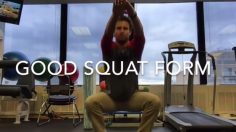
Unless you’ve been living in a cave, chances are good that you’ve heard of CrossFit® by now. Chances are also good that you’ve heard CrossFit is dangerous. You may have even heard tales of people being hospitalized by CrossFit workouts.
At Washington Orthopedics & Sports Medicine, we’ve heard these tales too but what we haven’t heard or seen any data to back it up. The truth is that we don’t really know if CrossFit is any more dangerous than other fitness programs. There is no quality research available on injury rates; the one major study published on the subject was fundamentally flawed and resulted in multiple lawsuits and retractions. What we do know is that any form of exercise can be dangerous if the participant is unprepared for it.
Just as we did in our running and cycling articles posted a few months ago, we’re going to take a closer look at CrossFit and some common problems we see CrossFitters experience so that you can go into tomorrow’s WOD prepared for success.
What is CrossFit?
CrossFit is an exercise regimen developed by former gymnastics coach, Greg Glassman.1 Since he opened the first CrossFit gym in 1995,2 his brand has grown exponentially, with over 11,000 affiliated gyms worldwide today and an annual championship event known as The CrossFit Games.1 In its own words, CrossFit is “…constantly varied functional movements performed at a relatively high intensity.”1 The workouts change daily, involve a wide variety of exercises which range from Olympic weightlifting to gymnastics, and are scalable so that an elite athlete as well as a sedentary individual can theoretically perform the same work out side-by-side according to their individual level of ability and fitness.
Why do training injuries happen?
CrossFit combines exercises and ideas from a variety of doctrines, which are all extremely challenging in their own right. These exercises become even more challenging when they’re combined and put under time constraints, as is often the case in CrossFit workouts. Participants in CrossFit classes need to assume responsibility for developing proficiency in these movements before performing them as part of an intense exercise routine. Research has shown that fatigue and spikes in training volume cause injury, not intensity of training alone3. What this means is that if you learn how to do the components of a CrossFit workout well, slowly increase the amount of work you do (over months rather than weeks), and diligently monitor the quality of your work during CrossFit classes, you can significantly decrease the risk of injury.
Common problems
When it comes to the movements and exercises common to CrossFit, the three common problems I see when I treat Crossfitters are:
- Poor squatting mechanics
- Poor hip hinge mechanics
- Bad overhead position
The ability to properly squat, hip hinge, and reach overhead underlays almost all of the major movements and exercises used in CrossFit workouts. If you can’t perform these basic movement patterns well on their own, you are asking for trouble when the workout of the day calls for you to do 100 of them as quickly as you can. The following videos show examples of proper movement patterns and a few of the corrective exercises I prescribe for those struggling with them. Try incorporating them as warm-ups before your workout or “homework” while you’re away from the gym.
The squat
- Basis for all barbell squats, box jumps, jump rope, burpees, and running
- Starting Position: Feet should be slightly wider than your hips, turned out 5–15 degrees, arms straight, reaching forward
- The Descent: Bend your knees and hips at the same time. Knees should travel slightly forward but not go too far beyond the toes. Hips should travel back slightly as you sit down. Feet should remain flat on the ground; try not to rock back onto your heels or forward onto your toes. Arms should reach forward and slightly upward.
- The Ascent: Keep reaching upward with arms as you straighten your knees and extend your hips. Don’t let your knees cave in and squeeze your glutes at the top of the movement
The hip hinge
- Basis for all deadlift variations, Olympic lifts, and most kettlebell exercises
- Starting Position: Practice this with a dowel along your back (should touch head, midback, and tailbone at all times). Set up is very similar to the squat.
- The Descent: Bend forward at the waist, pushing your hips backwards, bending the knees slightly. Your torso should be almost horizontal at the bottom and you should feel tension in your hamstrings.
- The Ascent: Stand up, straighten your knees, and squeeze your glutes.
Overhead position
- Basis for shoulder press, jerks, snatches, handstands, pull-ups, and wall ball.
- You should be able to reach overhead with your elbow straight, upper arm completely vertical, and thumb pointed backwards. You should be able to do this without feeling any pinch in your shoulder, craning your neck, or arching your back.
The ability to perform these basic movement patterns is the prerequisite to performing many of the maneuvers you’ll see in CrossFit workouts. If you’re having trouble with any of these three, contact us so one of our therapists can help create an individualized plan to keep you working out safely.
Want to know more?
For more information about movements and exercises associated with CrossFit, email us or request an appointment. Be sure to follow us on Facebook and Twitter as well!
 Kevin McGuinness is a physical therapist at the SMARTherapy Center at Washington Orthopaedic & Sports Medicine and is a Certified Strength and Conditioning Specialist. He received his Doctor of Physical Therapy degree from George Washington University in 2013 and works with a wide range of patient populations, including high school, college, and professional athletes, as well as patients with spinal cord and traumatic brain injuries.
Kevin McGuinness is a physical therapist at the SMARTherapy Center at Washington Orthopaedic & Sports Medicine and is a Certified Strength and Conditioning Specialist. He received his Doctor of Physical Therapy degree from George Washington University in 2013 and works with a wide range of patient populations, including high school, college, and professional athletes, as well as patients with spinal cord and traumatic brain injuries.
